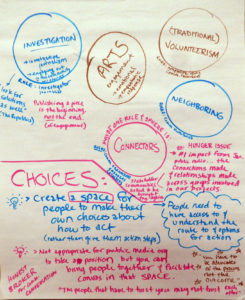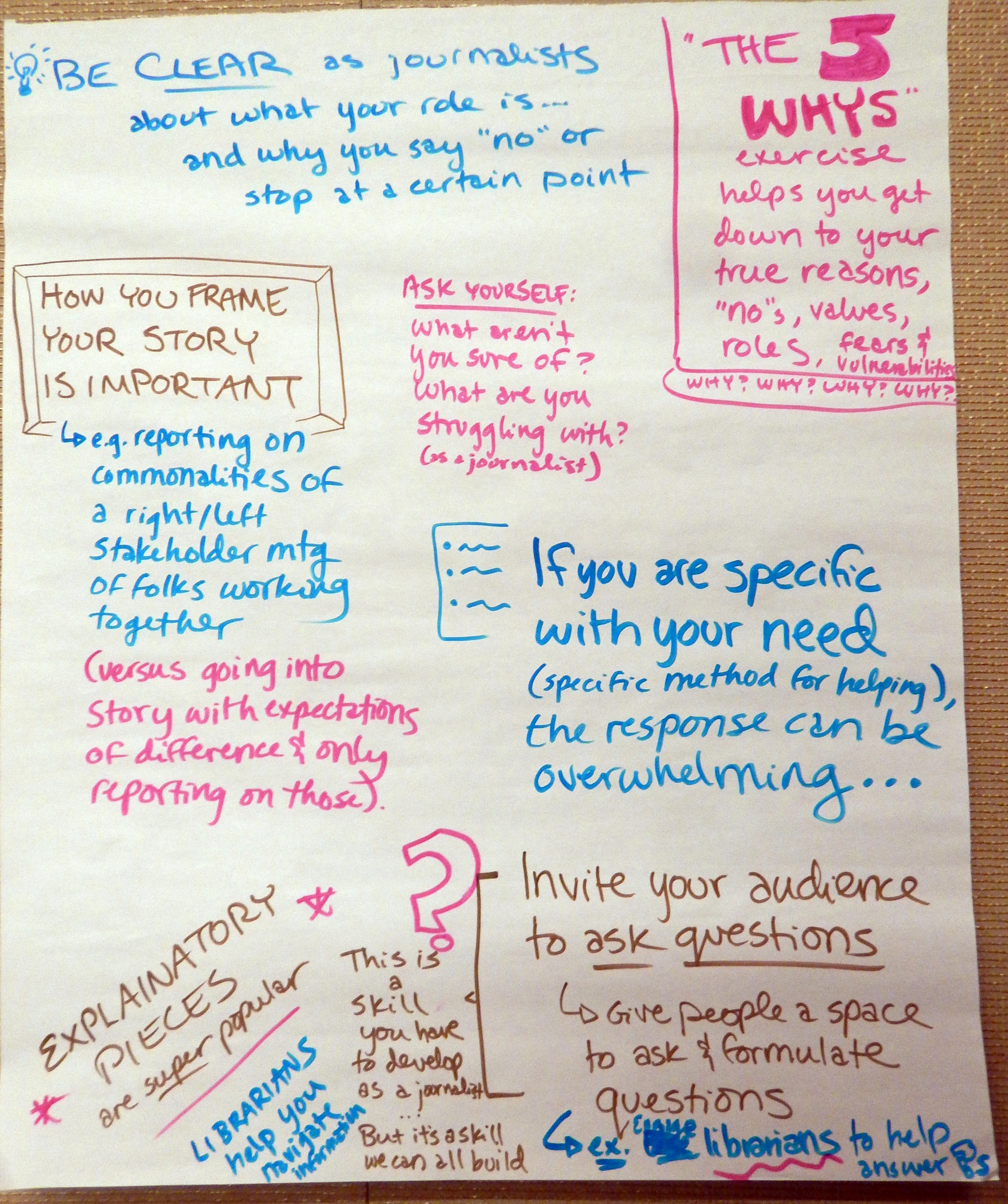- Advocacy journalism (i.e. Jana, who is a videographer for the tiny house movement)
- Activism
- Public service’ (i.e. volunteering)
- Decision making
- Stakeholder gatherings/events
- Provoking emotion/thought through words, art
- Online spaces
- Connectors
- Informal community engagement
 Fiona/Jerry: There’s power to the everyday, informal engagement: PTA meeting, soccer field, etc. Is engagement what we’re doing right now in this circle?
Fiona/Jerry: There’s power to the everyday, informal engagement: PTA meeting, soccer field, etc. Is engagement what we’re doing right now in this circle?
Marissa: I work as a city planner. We always hear from folks about a topic, and pass that to policy makers. Our goal is always engagement. We have kiosks that are a visual representation of what the city is working on. (Marla: Those are not very cost effective. Something like $25,000 per kiosk.)
Fiona: The PTA doesn’t look like the school, which is diverse. Parents are working, have multiple jobs. Transportation and time are the problem. Take it to them at the laundromat. Spaces like that.
Marissa – We try to go where people are at: childcare spaces, churches, farmers markets, parks, DMV.
Fiona: Online people can respond immediately to what just read. We need to make the connections. We need to find new ways to get some traction. But how do that in a way that preserves our role?
Carrie – Look for solutions. We did a story about the foster care systems and it saw a surge of new parents because of a success story. If publish a piece it doesn’t have to be the end of it. Balance and sustainability.
Marla – Need to give people choices, tradeoffs. Engage people in a deliberate process.
Jerry – Wildflower Foundation in San Francisco looks for the informal leaders in pockets of communities i.e. barbers. That’s where the action is happening. Seeing one action happening in a community is easier to swallow.
Jesikah – Even in areas where there are limited choices each person should be able to come up with their choice about whether to act or not. Need to be careful about providing ways forward but still respecting their right to decide. Need to think about the public framing for encouraging people to make those choices, get the value out.
Fiona – Solutions journalism…how to navigate the system, the process, how to ask questions.
Celeste – Because I interview social entrepreneurs, changemakers, etc. about what they’re doing and how and they’re challenges, I’m always making connections between them. This women over here is having trouble with X so I connect her with this other women over there who just worked through that problem. It feels weird to withhold that information.
Marla – I did that. I connected the governor and a candidate because they both had a passion for education and I thought it’d be an interesting interview with both. For better or worse No Child Left Behind came out of that. Connectors in the community is an engagement sphere in and of itself.
Jesikah – The #1 impact we’ve seen of our projects is that different groups who didn’t know each other started working together across projects. And that really made the case for funding these engagement initiatives.
Fiona – Example?
Jesikah – We did a project revolving around hunger in Sacramento. We had monthly meetings, advisory group, stakeholder convenings with these groups and became sort of a hub. Twelve people who didn’t know each other worked together over a year and now do. I identify as a community organizer even though I wouldn’t necessarily say that where I work. Social justice and advocacy often overlap but don’t have to. We need new ways of bringing the newsroom and people together to tell accurate, nuanced stories. Maybe there’s a whole world full of community organization we can turn to and learn from. But there’s a certain comfort level to break through. It’s not appropriate for a public media org to take a position or try to move people to policy to change action.
Fiona – You can’t give your opinion. You need to stay out of the convo at a certain level but you can facilitate conversation in a way. People have to trust you, you can’t show favoritism. There’s a certain comfort level as a journalist you’re playing with.
Marissa – You need to be representatives of the process and not the outcome.
Marla – Find a topic where there’s a consensus for the common good. Everyone wants to increase the high school graduation rate. The T.V. and radio stations formed an alliance for coverage because it was something everyone agrees on as a good idea.
 Jesikah – People in the newsroom would say – we listened to the people, it’s a top priority, we have a responsibility to inform our public.
Jesikah – People in the newsroom would say – we listened to the people, it’s a top priority, we have a responsibility to inform our public.
Fiona – You’re deeming what’s important in the decision
of what you don’t cover.
Carrie – You don’t have to advocate for a specific method or solution, just show what’s out there.
Marissa – Tree Code. Everyone has emotional rxn to trees. Everyone agreed sh*t wasn’t working. Can start from place of agreement. Our stakeholder groups were polarized but they had more in common than they thought.
Jerry – How then to get people to think of the common purpose? That can be fairly neutral.
Tim – Paradox of actually having to follow the “no” so you can uncover the “yes.” People often have less differences than they perceive. Go in detail to explore the “no” and what in particular it stands for.
Marla – Opposite of appreciative inquiry
Marissa – We’d do a quick vote at our stakeholder meetings. Red card, yellow card, green card. People check in to see where they’re at. Ask what would help them go from red to yellow.
Fiona – Why don’t we think of ourselves as community organizers?
Marla – If you make a choice to do that as a journalist, you need to make that clear from the beginning.
 Jesikah – Make clear what your values are about. If you get pushback in the newsroom it could be helpful to do a 5 Why’s Exercise. It’s a good way to uncover what people’s values, mission, and passion are. Why are you doing this? Etc. It’s a way to find the common good. Might find you have the same values as someone you work with but didn’t know it.
Jesikah – Make clear what your values are about. If you get pushback in the newsroom it could be helpful to do a 5 Why’s Exercise. It’s a good way to uncover what people’s values, mission, and passion are. Why are you doing this? Etc. It’s a way to find the common good. Might find you have the same values as someone you work with but didn’t know it.
Tim – You’d also find their fear and vulnerabilities
Marla – My sister works in theatre and a lot with the body. She’s says, “Before you engage with others, you need to engage with yourself.”
Jana – Found music really works with Alzheimer’s patients.
Fiona – Journalists don’t want framing clichés. Agreement is the starting point. Allow journalists to recognize what’s interesting to them, what are the commonalities. But if they’ve already decided what the story is going to be they’re not going to be open.
Jerry – Find the deeper purpose.
Marla – Let’s give space to people working through issues, ambivalence. We don’t have to be clear. Maybe ask, What aren’t you sure of? What are you struggling with?
Carrie – Give readers very specific methods, information to get to a solution
Fiona – I’d like to know what reader’s questions are. Give them a space to ask questions. Maybe at the bottom of the story – What questions do you have for the reporter/in general about this issue? Reporter could get involved in the comments section. Those explaining pieces are really popular.
Tim – Questions can be used to steer
Marissa – We use librarians for research a lot because they’re neutral.
Marla – ALA and Harvard are working on a project to meaningful engage communities and connect them to the library
Fiona – Libraries help you navigate information. Reporters need to be more like a community organizer/librarian to archive, hold knowledge in a way where people can really access it.

